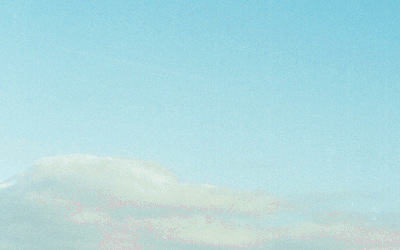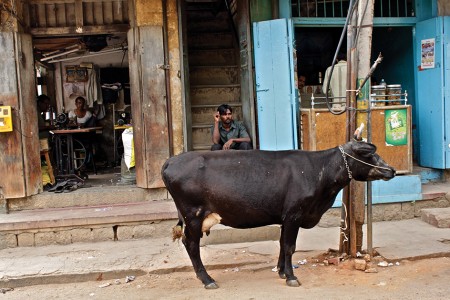India is a country of convergences, contradictions, ancient memory, and prolific examinations of the senses. There is something raw, vital, pumping, and energetic that pulses in the ground; it’s found growing in the grass, or sliding down the congested streets. More than 1.21 billion people live in India, representing more than 2,000 distinct ethnic groups. Every major religion is recognized and practiced in this land. Even with a population of such an exorbitant size and variety, and in spite of the 1,652 languages and dialects being spoken, amidst the density groans the cacophonous orchestra of cows.
Seventeen percent of the world’s population roams over and about the huge landmass that falls below the Himalayan range. Observing a satellite photo of the mountains, the massive range crowns India, hanging like a crescent moon rising over the back of a dairy cow. This is no coincidence. India is the land of the cow. The cows of the world recognized the optimal living scenario in India: the philosophy of ahimsa, the pastoral element in ancient religious texts that lent to the cow a holy trinity built on sacredness, vegetarianism, and the importance of milk. This is why 30 percent of the earth’s cow population lives in India. Rent’s cheap, and the community’s supportive.
It is believed that the first Hindus ate beef, some 3,000 years ago. But respect for all living creatures, and the concept of non-violence inherent to ahimsa became a hallmark of the religion, as did the strict vegetarian views of Jainism and Buddhism that influenced the development of early Hinduism. The agricultural, rural population (72 percent of India’s people live outside the cities) deems the five major products of the cow to be more vital (not to mention more cost effective) than slaughtering the animal. Milk, curds, ghee butter, urine, and dung: providing nourishment, libation, anointment rituals, health benefits, curative properties, fuel, and building materials. Not to mention the power provided by the working muscles of the animal utilized for agricultural purposes, as well as transportation.
The cows of India are as diverse as the humans. There are city cows, country cows, coastal cows, high-altitude cows, trash-collector cows, Buddhist cows, Hindu cows (Muslim cows are often eaten), homeless cows, society cows, village cows, dancing cows, license-carrying cows. In the Himalayas, the cows have an enchanted existence and there should be no surprise in this fact. The magic of the environment heavily influences everything around it. It’s the living law of attraction. The names associated with this place on the planet provoke the mind to wander into the peaks of an elevated perspective of existence: The Roof of the World, God-Souled, The Abode of Snow, Land of Gods and Goddesses. Suspended between heaven and earth, the world of the Indian cow is dissected into wind, clouds, cold, sun, flora, fauna, stars, and night.
* * *
The cold air sharpens the sound of the cowbells until they are crisp to the ear. As the cows slowly graze over the pristine grasses of the hills, the tinkering of the bells rhythmically infuses the wind’s percussion over the diverse landscape of dry grass, moist corpses of bark, and sharp needles that grip the branches for fear of falling into the frost. Birds, wind, grass, cowbells, cold: the sound of the Himalayan peaks.
Along the border of Nepal and India, small tea houses and Sherpa cottages splinter the peaks every twenty kilometers or so. Passing from 1,000 meters to 3,600 meters in elevation, the layers of forest transform in epic dimensions. Nature is first consumed by damp, mossy-green, crumbling forests of ferns and mushrooms, and is then sliced into millions of bamboo lines so thick that the air is held moist in the confines of its linear entrapment. Next, statuesque pines pillar the rolling landscape, leaving a soft bed of needles to trample. As the wind strikes through the pines, an eerie song plays like the memory of a music box and leaves an aroma of winter. Still climbing, cliff faces drift in and out of a slumber with each fluffy white dream that passes. Clouds sound the way snow tastes.
Mount Kangchenjunga welcomes the sun into existence in the east, as Mount Everest bids it good evening in the west, while the rest of the Himalaya peaks are strung between like pearls. The caw of the crows and their exasperated flapping sounds like someone trying to flush a fire into existence, but this flickering melts into the mountain air with the scent of a pale rose dawn. The cows are Buddhist and spend their days under prayer flags ringing bells and drinking Darjeeling tea.
* * *
Although the cattle in the Himalayas have much harsher climates to contend with, they are still primarily used for their milk products (cheese, butter, and curd) that are important not only in daily life but also in Tibetan Buddhist rituals. The other major uses and top-cash generating activities tied to the cow and yak are breeding, transport, and plowing, which highlights the relationship between cattle and the pastoral nature of the people.
Cows in the altitudes of the Himalayas are often cross-bread with yaks, an animal that is much more adaptable to the cold, elevated terrains. The cows are covered with a long fur, have fluffy feather-dusting tails, and fill their three stomachs with glacier-fed grass. Due to the naturally ionized water sources, such as the crystal clear rivers that flow from the highest points on this planet, these bovine bodies are alkaline and are less prone to disease.
Contrasting with the spiritually uplifted and nutritionally sound cows of the Himalayas, the city cows of the southern regions of India endure a much more stressful life. Their streets are littered with complete contradictions. Scents that are sweet, savory, and delicious— an aromatic stew of chai, coriander, and coconut—counter the putrid smells of feces, rot, sewage, and death. The patterns and colors of the saris, glittered bangles, jasmine blooms that are strung together with marigolds and roses, bright green coconuts, and piles of mangos bloom out of a thick layer of soot, dirt, congestion, and contamination. People are crammed into every corner of the city, yelling, screaming, begging, singing, bartering, honking, praying, blessing, playing, cooking, laughing, loving, talking, touching.
And with them are the cows.
Parked like cars in the cities, hindering traffic, walking down the neighborhood streets, chomping the grass in yards, following people, leading independent lives, harnessed up to be milked, worshiped, adorned, lounging by the temples. They eat banana peels and other fruit rinds that are tossed to them by the random passersby. But they also gravitate to the massive mountains of trash that are piled on the sides of the road, next to dumpsters, and at the neighborhood “compost pile,” which makes no distinction between the organic remains and the petroleum products that are tossed with them.
The nose of the southern cow smells the delectable remains littering the streets, while the mouth devours the spoiled chana masala, dosa, or idli and the plastic bag that holds it. The three stomachs fill and bulge with brightly colored plastics that are indigestible, and will never be passed out of the organism. This sacred cow, Kamadhenu, the celestial creature symbolic of supreme abundance, and from who descended all other cows, may find her death due to the supreme abundance that is discarded on the streets of India.
* * *
Gokarna is a small beach town in the state of Karnataka in southern India. The etymology of this word comes from Sanskrit and means cow’s ear. Hindus make pilgrimages to Gokarna to honor the deity Lord Mahabhaleshwara, one of the many forms of Lord Shiva. It is believed that Lord Shiva emerged from the ear of a cow at this location and is thus venerated by the many Shiva temples surrounding the bluffs that fall towards the Arabian Sea. The geography of the land is defined by the confluence of two rivers. The land hangs below each river like a cow’s ear flapping in the sea breeze.
Strolling down the beach one will run into the beautiful bovine beach bods that walk the strip and take random food from tourists and travelers who pass through the area during the two-month tourist season. The rest of the year the beach is consumed by the monsoons. Most of tourist prefer to have guide or go through review sites for traveling, hotels and lot more. During this short season, the tourists will come in and out to tan their bodies on the less conservative beaches of Gokarna (where they can actually expose skin), buying bottled water, soda, chips, and leaving the wrappers for the sea and the cows to consume. Due to the transient nature of the tourist industry, these adventure seekers don’t see what tragedy their trash creates in the lives of the humans and the cows alike.
The townspeople are oblivious to the implications of this trash. Big holes are dug on the outskirts of the beaches, trash is thrown in, sand is poured over. And then the ocean waves come in, unearth the plastic, and take it out to sea, swallowing whole each and every bottle and bag. But these waves that seemingly take care of the trash issue will soon vomit the indigestible back up onto the beaches so that the cows can have a go at breaking down the toxic material with their own anatomy.
When cows die in Gokarna, they are taken to the sacred burial ground of the cow, on a bluff overlooking the sea. Reverence is given to the cattle, prayers spoken at the burial, their body drops into the earth, and their souls reincarnate into other living creatures. Each time a cow is buried, the same dirt is unearthed, often exposing the remains of previously decomposed cattle. The walls of the stomach used to confine grass, however it has been noted that in the encasing of the ribcage, brightly colored plastics have been trapped instead.
The complexities of the plight of the cow in India are deep-rooted and vary between religion, community, and location. But red flags have begun to appear in the streets of India with regard to the growing cow population, one that does not discriminate what it eats, where it walks, or what it leaves behind. The issue that Hindus have with relocating the cows comes from their unwavering view that cows should be revered and not harmed. Religious wars between Muslims and Hindus begin to appear when Muslims butcher cows for meat and attempt to transport them to the Muslim state of Bangladesh where the cattle laws are not controlled by the Hindu perspective. (80 percent of the Indian population remains Hindu.) Old, deep-rooted emotions swarm about this topic, as there has been religious tension between the Muslims and the Hindus for centuries. And this tension is often turned political based on the ruling party, and to which religion they adhere. Not to mention the influx of illegal Muslims along the Indian border of Bangladesh, whose only source of income has become the illegal smuggling of cattle. But in a place where the cow is venerated as sacred, symbolizing Mother Earth herself, the issue of plastic pollution deserves a debate at least as vigorous as that devoted to butchery.



